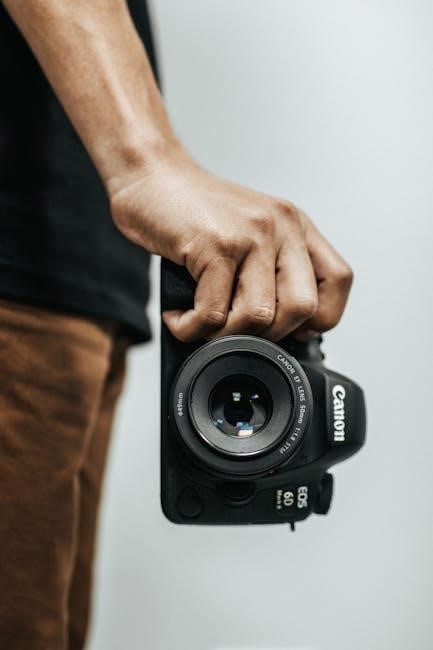Welcome to the Canon EOS 7D Mark II, a powerful APS-C DSLR designed for sports and wildlife photography. It features a rugged weatherproof design, enhanced autofocus, and superior image quality, making it a top choice for professionals and enthusiasts alike.
Key Features and Improvements
The Canon EOS 7D Mark II boasts a 20.2MP APS-C CMOS sensor, Dual Pixel AF, and 10fps continuous shooting. It features a 65-point all-cross-type AF system, improved weather sealing, and a 100% viewfinder. The camera supports Full HD video recording and offers enhanced noise reduction. Its advanced metering system and customizable controls ensure precise photography. These upgrades make it a robust choice for sports, wildlife, and action photography, delivering high performance and reliability.
Overview of the Instruction Manual
The Canon EOS 7D Mark II instruction manual provides comprehensive guidance for mastering the camera. It includes detailed explanations of features, shooting modes, and customization options. The manual covers setup, autofocus, metering, and video recording. Available in PDF format, it ensures users can access it digitally. Tips for troubleshooting and maintenance are also included, making it an essential resource for both beginners and advanced photographers to optimize their camera’s performance and achieve professional results.

Camera Layout and Controls
The Canon EOS 7D Mark II features an intuitive layout with weather-sealed controls. The top includes a mode dial, shutter release, and ISO button, while the rear offers a touchscreen for easy navigation and settings adjustment, ensuring efficient operation in various shooting conditions.
Front and Top Controls
The Canon EOS 7D Mark II features a weather-sealed design with intuitive front and top controls. The top plate includes a mode dial, shutter release, ISO button, and AF-ON button for quick access. The front houses the lens release button, depth-of-field preview, and lens controls like zoom and focus rings. The ergonomic design ensures easy handling, with controls positioned for intuitive use during shoots, even in challenging conditions.
Rear Controls and Button Functions
The rear of the Canon EOS 7D Mark II features a 3.0-inch LCD screen for image review and menu navigation. Key controls include the Quick Control Dial, AF Point Selection Button, and Multi-function Button, which provide fast access to camera settings. The rear buttons allow quick adjustments to autofocus, metering modes, and playback functions, streamlining your shooting workflow. These intuitive controls enhance efficiency and customization, making it easier to adapt to various shooting scenarios.

Basic Shooting Modes
The Canon EOS 7D Mark II offers various shooting modes, including Auto, Program (P), Aperture Priority (AV), Shutter Priority (TV), and Manual (M) modes, catering to different photography needs and skill levels.
Understanding Auto, P, AV, TV, and M Modes
The Canon EOS 7D Mark II offers multiple shooting modes to suit various photography needs. Auto mode simplifies settings for beginners, while Program (P) mode provides flexibility. Aperture Priority (AV) mode controls depth of field, and Shutter Priority (TV) mode manages motion capture. Manual (M) mode grants full creative control, allowing photographers to adjust both aperture and shutter speed for precise results. Each mode caters to different skill levels and creative preferences, ensuring optimal image capture.
Using Live View and Video Shooting
The Canon EOS 7D Mark II offers advanced Live View and video shooting capabilities. Live View allows for precise composition on the LCD screen, while video mode supports high-quality recording with frame rates up to 60p in Full HD. Dual Pixel CMOS AF technology ensures smooth and accurate autofocus during video capture. Touch focus and manual controls provide enhanced creativity, making the 7D Mark II a versatile tool for both stills and video enthusiasts.
Autofocus System
The Canon EOS 7D Mark II features a 65-point all cross-type AF system for precise subject tracking. Dual Pixel CMOS AF enhances video autofocus speed and accuracy, ensuring sharp focus even with moving subjects.
Advanced AF Modes and Customization
The EOS 7D Mark II offers advanced AF modes, including Large Zone AF and AF Point Expansion, allowing for dynamic subject tracking. Users can customize AF settings, such as tracking sensitivity and acceleration/deceleration, to suit their shooting style. Additionally, the camera supports AF point selection via the Quick Control Screen, enabling precise control over focus acquisition and ensuring optimal performance in various lighting conditions and subject scenarios.
AF Point Selection and Expansion
The EOS 7D Mark II allows precise AF point selection, with 65 cross-type points for accurate focus. AF Point Expansion enables users to expand focus areas, enhancing subject tracking. Manual selection via the Quick Control Screen ensures flexibility, while customizable AF zones streamline workflow, making it ideal for capturing dynamic scenes with ease and precision in diverse shooting environments. This feature-rich system ensures sharp focus in challenging conditions.

White Balance and Picture Styles
The EOS 7D Mark II offers precise white balance control, ensuring accurate colors in various lighting conditions. Picture Styles allow customization of image sharpness, contrast, and color tone to suit personal preferences, enhancing creative control and consistency in your photography workflow. These features enable photographers to achieve professional-grade results with tailored settings for every shot.
The Canon EOS 7D Mark II allows you to set white balance manually or choose from predefined options like Daylight, Shade, and Tungsten. Auto White Balance is reliable but for precise control, use the Custom White Balance option by shooting a white object under the lighting conditions. This ensures accurate color rendition, as the camera calibrates to the specific scene. For convenience, you can save up to five custom white balance settings for quick access. This feature is particularly useful in mixed lighting environments, helping to maintain consistent and natural-looking colors in your images. The process is straightforward and can be accessed through the camera’s menu, making it easy to achieve professional-grade color accuracy every time you shoot. By utilizing these options, photographers can enhance the quality and authenticity of their photos. The Canon EOS 7D Mark II allows you to customize Picture Styles to suit your creative vision. Choose from predefined styles like Standard, Portrait, Landscape, Neutral, Faithful, and Monochrome. Each style adjusts parameters such as sharpness, contrast, saturation, and color tone. For added personalization, you can fine-tune these settings or create and register your own custom styles. This feature ensures your images reflect your unique artistic preferences, whether you’re shooting portraits, landscapes, or black-and-white photography. The camera also supports saving up to three custom Picture Styles for quick access, making it easy to maintain consistent looks across your work. By tailoring these settings, you can enhance the emotional impact of your photos and achieve professional-grade results tailored to your style. This level of customization is a powerful tool for photographers seeking precise control over their imagery. The Canon EOS 7D Mark II offers various metering modes to measure light accurately, adapting to different scenes for optimal exposure and enhanced image quality. The Canon EOS 7D Mark II features four metering modes: Evaluative, Center-Weighted, Spot, and Partial. Evaluative metering analyzes the entire scene for balanced exposure. Center-Weighted prioritizes the central area, ideal for portraits. Spot metering measures a small, precise area, perfect for high-contrast scenes. Partial metering covers a larger area than Spot, offering a compromise between accuracy and flexibility. Each mode tailors exposure to specific lighting conditions, ensuring optimal results in various shooting scenarios. Spot Metering focuses on a specific area (1-2% of the frame) for precise exposure control, ideal for backlit subjects. Center-Weighted Metering prioritizes the central 8% of the frame, balancing subject and background exposure. Evaluative Metering analyzes the entire scene, considering brightness, color, and subject distance for accurate results. Each mode offers unique advantages, allowing photographers to adapt to various lighting conditions and achieve desired exposures with ease and precision. The Canon EOS 7D Mark II offers ISO settings from 100 to 16000, enabling shooting in various lighting conditions. Noise reduction features help maintain image quality at higher ISOs. For bright lighting, use lower ISOs (100-400) to avoid overexposure and maintain image quality. In low-light conditions, increase ISO (up to 16000) to capture more light, but be cautious of noise. Use Auto ISO for convenience, letting the camera adjust settings automatically. The 7D Mark II’s noise reduction features help minimize grain, ensuring clearer images even in challenging lighting scenarios. The Canon EOS 7D Mark II includes built-in noise reduction features to minimize grain in low-light images. Enable High ISO Speed Noise Reduction for cleaner results at higher ISOs. Use the Multi-shot Noise Reduction for stationary subjects to blend images and reduce noise. For best results, shoot in RAW and apply noise reduction during post-processing. Disable noise reduction for RAW+JPEG to avoid over-processing. Experiment with settings to balance detail retention and noise reduction effectively. Personalize your EOS 7D Mark II with custom functions, enhancing shooting efficiency. Configure settings to suit your preferences for optimal performance and streamlined workflows. Custom functions on the Canon EOS 7D Mark II allow you to tailor camera settings to your shooting style. Configure options like autofocus modes, exposure controls, and button assignments for streamlined workflows. Access these functions through the menu, enabling personalized adjustments to enhance efficiency. These configurations ensure your camera is optimized for your creative needs, delivering improved performance in various photography scenarios. Customize buttons and My Menu on the Canon EOS 7D Mark II to streamline your workflow. Assign frequently used functions to buttons like the Quick Control Dial or Multi-controller for easy access. My Menu allows you to save up to six personalized settings, ensuring quick adjustments during shoots. This feature enhances efficiency, enabling you to focus on capturing moments without navigating complex menus, optimizing your camera setup for your unique photography style. Regular firmware updates ensure optimal performance and access to new features. Visit Canon’s official website for the latest software. Regular maintenance keeps your camera functioning smoothly. To ensure your Canon EOS 7D Mark II performs optimally, regularly update its firmware. Visit Canon’s official website, navigate to the support section, and enter your camera model to find the latest firmware version. Download and install the update using the provided instructions. Firmware updates often include new features, performance enhancements, and bug fixes. Always follow the on-screen instructions carefully to avoid interruptions during the update process. Use Adobe Acrobat Reader to view PDF manuals if needed. Regular maintenance ensures your Canon EOS 7D Mark II performs at its best. Clean the sensor and lens regularly using a soft cloth and lens cleaning solution. Store the camera in a dry, cool place, away from direct sunlight. Use a protective bag to prevent scratches. Check battery and memory card conditions regularly. Refer to the PDF manual for detailed cleaning instructions and maintenance schedules to keep your camera in optimal working condition. Resolve error messages by checking the manual or Canon support. Clean the sensor and lens for optimal performance. Address autofocus and exposure issues by adjusting settings or updating firmware. Error messages on the Canon EOS 7D Mark II often relate to lens issues or camera-body communication. Ensure the lens is properly mounted and clean the contacts. For sensor cleaning, enable the camera’s self-cleaning mode or manually clean with swabs. Regularly check for firmware updates to prevent errors. Refer to the manual for detailed troubleshooting steps and maintenance tips to keep your camera functioning optimally. For autofocus issues, ensure the lens is clean and properly attached. Use manual AF point selection for precise focus control. If exposure is inconsistent, check the metering mode and adjust settings accordingly. Enable AF Point Expansion for challenging lighting conditions. For moving subjects, switch to AI Servo mode. Regularly calibrate your lenses for optimal performance and refer to the manual for advanced customization options to refine autofocus and exposure accuracy.Setting White Balance for Accurate Colors
Customizing Picture Styles for Personal Preference
Metering Modes
Understanding Different Metering Options
Using Spot, Center-Weighted, and Evaluative Metering
ISO Settings and Noise Reduction
Optimizing ISO for Various Lighting Conditions
Using Noise Reduction Features Effectively
Custom Functions and Personalization
Configuring Custom Functions for Enhanced Shooting
Customizing Buttons and My Menu
Firmware Updates and Maintenance
Updating Firmware for Improved Performance
Regular Camera Maintenance Tips

Troubleshooting Common Issues
Resolving Error Messages and Sensor Cleaning
Addressing Autofocus and Exposure Problems




